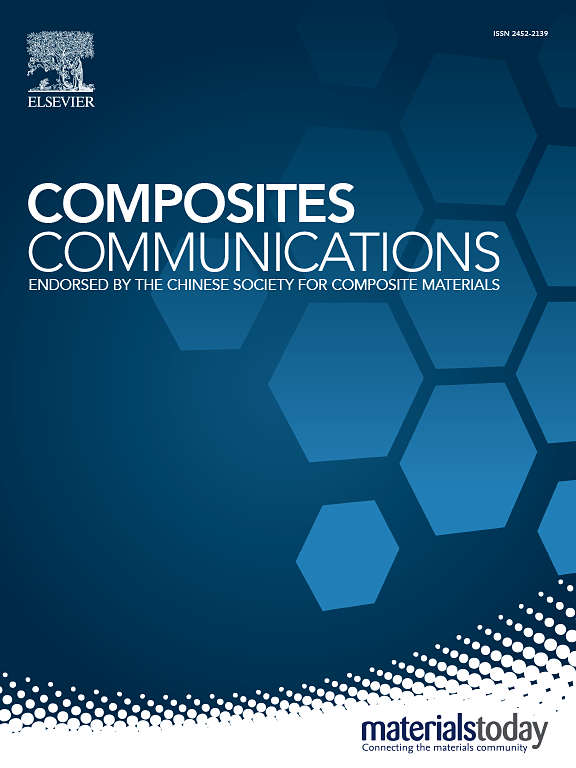Foam-Foam composites from foam wastes. A way to evaluate properties of irregular variable-shape small reinforcing pieces via a foaming assembly process
IF 6.5
2区 材料科学
Q1 MATERIALS SCIENCE, COMPOSITES
引用次数: 0
Abstract
The usual recycling methods for foam wastes result in the loss of the desirable porous structure of the raw material. To solve this, the present research work evaluates Foam-Foam composite panels as an innovative strategy to give a second use to end-of-life foams as foamed small pieces. These light and porous panels were successfully fabricated using macro-foamed fillers (the “small pieces” as reinforcement) and a polyurethane foaming resin that functioned as a very soft and adhesive assembling matrix. The reinforcement foams included chips of end-of-use thong sandals and extruded foamed rods (production waste polymers), which were employed separately, obtaining different foam-foam composite panels. Extruded foamed strands comprised either rigid thermoplastic foams (polymethyl methacrylate, PMMA) or soft thermoplastic elastomer foams (Pebax). Remarkably, this foaming assembly method allowed a random-like fabrication of reproducible composites containing high-volume fractions of reinforcement foam wastes, ranging from 30 % to 50 %. Results showed that such Foam-Foam panels exhibit predominantly the properties of the dispersed phase, even if the reinforcing lumps were highly heterogeneous in shape, size and orientation. Moreover, some mechanical properties (eg, compression modulus and strength, energy absorption, and rebound coefficient) displayed outstanding reproducibility. Some of these materials exhibited a very low thermal conductivity (0.032 W/m/K), suggesting their potential as thermal isolating panels. Therefore, it can be claimed that “foaming assembly” is an efficient way to introduce new types of Foam-Foam composites and to valorize any type of foam when they are only available as disparate or small pieces, i.e., scraps, crushed waste, extrusion rods/strands, plastic rushes, etc.
泡沫-由泡沫废料制成的泡沫复合材料。一种通过发泡装配工艺评价不规则变形状小补强件性能的方法
通常的泡沫废物回收方法会导致原材料失去理想的多孔结构。为了解决这个问题,目前的研究工作评估泡沫-泡沫复合板作为一种创新的策略,给二次使用寿命结束的泡沫作为泡沫小块。这些轻质多孔板成功地使用了大泡沫填料(“小块”作为加固)和聚氨酯发泡树脂,作为非常柔软和粘合的组装基质。增强泡沫包括废弃的丁字拖碎片和挤出的泡沫棒(生产废料聚合物),它们被分开使用,得到不同的泡沫-泡沫复合板。挤出泡沫线由刚性热塑性泡沫(聚甲基丙烯酸甲酯,PMMA)或软热塑性弹性体泡沫(Pebax)组成。值得注意的是,这种发泡组装方法允许随机制造含有高体积分数的增强泡沫废料的可再生复合材料,范围从30%到50%。结果表明,即使增强块在形状、大小和取向上高度不均匀,这种泡沫板也表现出分散相的主要特性。此外,一些力学性能(如压缩模量和强度、能量吸收和回弹系数)表现出良好的再现性。其中一些材料表现出非常低的导热系数(0.032 W/m/K),表明它们具有作为隔热板的潜力。因此,可以声称“发泡组装”是一种引入新型泡沫-泡沫复合材料的有效方法,并且当任何类型的泡沫只能作为零散或小块(即废料,粉碎废物,挤出棒/股,塑料灯芯绒等)时,可以使其增值。
本文章由计算机程序翻译,如有差异,请以英文原文为准。
求助全文
约1分钟内获得全文
求助全文
来源期刊

Composites Communications
Materials Science-Ceramics and Composites
CiteScore
12.10
自引率
10.00%
发文量
340
审稿时长
36 days
期刊介绍:
Composites Communications (Compos. Commun.) is a peer-reviewed journal publishing short communications and letters on the latest advances in composites science and technology. With a rapid review and publication process, its goal is to disseminate new knowledge promptly within the composites community. The journal welcomes manuscripts presenting creative concepts and new findings in design, state-of-the-art approaches in processing, synthesis, characterization, and mechanics modeling. In addition to traditional fiber-/particulate-reinforced engineering composites, it encourages submissions on composites with exceptional physical, mechanical, and fracture properties, as well as those with unique functions and significant application potential. This includes biomimetic and bio-inspired composites for biomedical applications, functional nano-composites for thermal management and energy applications, and composites designed for extreme service environments.
 求助内容:
求助内容: 应助结果提醒方式:
应助结果提醒方式:


